三上英语易错易混淆知识点完整版
- 格式:docx
- 大小:177.68 KB
- 文档页数:5
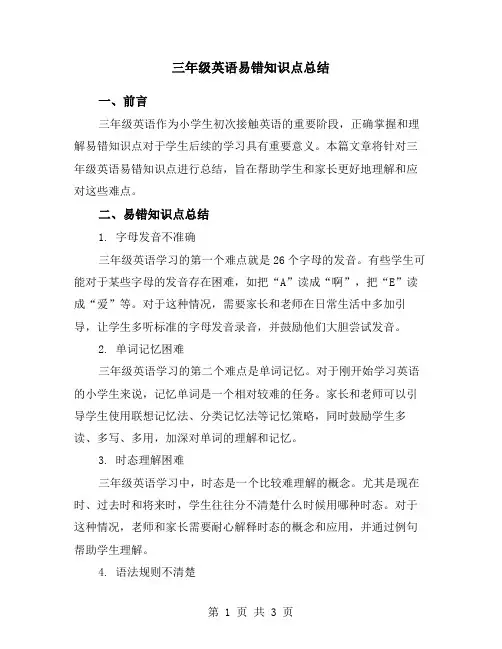
三年级英语易错知识点总结一、前言三年级英语作为小学生初次接触英语的重要阶段,正确掌握和理解易错知识点对于学生后续的学习具有重要意义。
本篇文章将针对三年级英语易错知识点进行总结,旨在帮助学生和家长更好地理解和应对这些难点。
二、易错知识点总结1. 字母发音不准确三年级英语学习的第一个难点就是26个字母的发音。
有些学生可能对于某些字母的发音存在困难,如把“A”读成“啊”,把“E”读成“爱”等。
对于这种情况,需要家长和老师在日常生活中多加引导,让学生多听标准的字母发音录音,并鼓励他们大胆尝试发音。
2. 单词记忆困难三年级英语学习的第二个难点是单词记忆。
对于刚开始学习英语的小学生来说,记忆单词是一个相对较难的任务。
家长和老师可以引导学生使用联想记忆法、分类记忆法等记忆策略,同时鼓励学生多读、多写、多用,加深对单词的理解和记忆。
3. 时态理解困难三年级英语学习中,时态是一个比较难理解的概念。
尤其是现在时、过去时和将来时,学生往往分不清楚什么时候用哪种时态。
对于这种情况,老师和家长需要耐心解释时态的概念和应用,并通过例句帮助学生理解。
4. 语法规则不清楚三年级英语学习的另一个难点是语法规则。
有些学生对于主语、谓语、宾语等概念不清楚,或者对于一些基本的语法规则如动词的变化、句子的结构等掌握不准确。
对于这种情况,老师和家长需要注重语法知识的讲解,并通过例句和练习帮助学生理解和掌握。
三、应对策略1. 培养良好的学习习惯对于三年级英语易错知识点,学生需要养成良好的学习习惯。
如每天坚持听录音、认真记笔记、积极参与课堂活动等。
同时,家长和老师也要给予学生足够的支持和鼓励,帮助他们树立学习英语的信心。
2. 注重基础知识的掌握对于字母、单词、时态、语法等基础知识,学生需要认真掌握。
可以通过多读、多写、多用等方式,加深对这些知识点的理解和记忆。
同时,家长和老师也要及时检查学生的学习情况,发现问题及时纠正。
3. 积极参加课外活动为了更好地理解和应用所学知识,学生可以积极参加课外英语活动,如英语角、英语比赛等。

人教PEP版小学英语三年级上册Unit 3 Look at me错题展示:一、将下列单词归类。
A.whiteB.noseC.bagD.pencilE.blackF.redG.penH.faceI.brownJ.mouthK.noseL.eraserM. yellowN.blueO.eye1. 文具用品类: .nose eraser yellow blue eye2.身体部位类:white nose bag pencil black3. 颜色类: red pen face brown mouth纠错解析:本题把上列单词分成了三类,只有明确每个单词的汉语意思才能正确分类。
正确答案:文具用品类:bag pencil pen eraser身体部位类:nose face mouth nose eye颜色类:white black red brown yellow blue二、根据情境,选择正确的答案。
(A)1、当你见到熟人问候时,你会说:_______A. Fine, thank you.B. How are you?(A)2、当你邀请别人一起玩时,你会说:_______A. OK.B.Let’s play.( B )3、—How are you?—______________.A.I am fine.B.Hi!(A)4、当你向别人介绍你的朋友Mike时,应说:_______ A. My name’s Mike . B. This is Mike.(A)5、与别人初次见面,应说:_______A. What’s your name ?B. Nice to meet you .(B)6、早晨,你见到同学时,你会说: _______A. Good morning.B. Good afternoon.(B)7、当你邀请别人一起画画时,你会说:_______A. Let's paint.B.Let's go to school.(A)8、当你想向朋友说这是鼻子时,你可以说:_______A. This is the leg.B.This is the nose.(A)9、当你想让大家都看着你,你应该说:_______A. This is me.B. Look at me.(B)10、当别人邀请你一起上学,你很乐意,你应该说:_______A. OK!B. Let’s go to school错因分析:1、 Fine, thank you.是 How are you? 的回答语。

1 三上英语易错点一、易写错的字母:大写:G (一笔) I (三笔) J (一笔) Q (第二笔不能写到“O ”里面) U (二笔) Y (“V ”下面是一竖)小写 d h i k l m n r u x v w不能顶格: t(下二格: p q g y(占三格: j f请你在四线格里写出26个字母,注意大小写:二、根据字母所给音标,请写出下列单词的首字母,注意单词一般情况都要小写:(注意横线上也要写手写体,这根横线是四线三格里的第三根线)/æ/ _nt /z/ _oo /b/ _ook /l/ _ong/k/ _rayon /d/ _uck /j/ _o-yo /e/ _lephant/p/ _ig /g/_ ift /h/ _and /t/ _iger/ʌ/_ mbrella /ai/ _ce /ks/ bo_ /d ʒ/ _ump/k/ _ite /n/ _oodles /m/ _um /kw/ _ueen/s/ _ix /r/ _ice /v/ _est /w/ _ater/ɔ/ _n /f/_ ace三、易混淆的单词和句子单词:ear white four pear cake hand this openeraser water five bear Coke head that close 句子:How are you? -Happy new year!-Happy new year!How old are you? -Happy birthday!-Thank you!I’m fine . –Have some juice.-Thank you./No, thank you. I’m five . -Can I have some juice?-Sure. Here you are. 其他易错句型: How many …?What colour?-Let ’s eat the cake/make a puppet/go to school. –Great./OK.-This is Sarah. –Nice to meet you.-I ’d like some bread. –Here you are.-Cool! I like it. –Thank you./Thanks.-Thank you. –You ’re welcome.-It ’s orange.(它是桔色的)/ It ’s an orange.(它是一个桔子)。

小学英语语法易错点总结7篇篇1一、报告背景在小学英语学习阶段,语法知识是学习英语语言结构的基础。
由于小学生处于语言学习的初级阶段,对于英语语法的掌握往往不够系统和深入,容易出现一些常见的错误。
本报告旨在梳理和归纳小学英语语法中的易错点,帮助小学生更好地理解和掌握英语语法知识,提高英语语言的运用能力。
二、常见易错点归纳1. 词类混淆(1)动词时态误用:小学生常常混淆不同形式的动词时态,如现在时和过去时。
例如,“I am go”(错误)与“I go”(正确)。
(2)名词单复数误用:对名词的单复数形式不敏感,如“I have a dog”(正确)与“I have dogs”(错误)。
(3)冠词使用不当:常忽略定冠词“the”和不定冠词“a/an”的使用规则,如“a an orange”(错误)。
2. 句子结构错误(1)主谓不一致:主语和谓语在数上不一致,如“She is play basketball”(错误)。
(2)缺少必要的语法词:遗漏be动词、助动词等关键词汇,如“I like play football”(缺少be动词)。
(3)疑问句结构错误:疑问句的构成要素使用不当,如“Are you live in Beijing?”(错误)。
3. 语境理解偏差导致的错误(1)情态动词的使用:对情态动词如can, should等的使用场景理解不准确。
如“You should to be quiet”(错误),未正确理解“should”后接动词原形。
(2)词义混淆:近义词混淆,导致句子意思表达不准确。
如使用“see”和“look”混淆的情况。
三、易错点解析及教学建议针对上述易错点,教师在教授过程中应注重以下几点:1. 强化基础训练:对词类、句子结构等基础语法知识点进行强化训练,确保学生能够熟练掌握。
2. 语境教学:通过实际语境教授语法知识,使学生能够在真实场景中运用所学知识。
3. 对比教学:对比相似或易混淆的语法点,帮助学生清晰地理解和掌握其差异。

三上英语易错易混淆知识点集团公司文件内部编码:(TTT-UUTT-MMYB-URTTY-ITTLTY-三上英语易错、易混淆知识点及题型整理1.字母容易易错、混淆的:(1)小写a和d书写规范,否则容易混淆,尤其是小写d的竖稍微长点;Gg的格式;(2)i(手写体和印刷体的区别,手写体I大写有两横);(3)Ii和Ll的区分,单独的I到底是大写I还是小写的l,主要根据前后给的字母是大小写来判断,如果前后给的字母都是大写,那么l是大写I的可能性大,若前后都是小写,那么l很有可能是小写l;(4)j(手写体和印刷体的区别,手写体大写J有一横);(5)Pp和Qq书写容易混淆,分清p和q半圆的方向;(6)Tt,小写t注意竖弯不顶格写,另外竖弯是小弯,不能写成汉字“七”;(7)Uu,大写U没尾巴,小写有尾巴;(8)Yy大小写格式要注意,小写不能写成印刷体,要写成手写体;(9)听力题中,注意Rr和Ii的发音区别;(10)首字母大写的几种情况:一、句子开头,首字母大写;二、圆点.句号后第二句开头首字母也要大写;三、外国人人名首字母大写,如:Mike;中国人名字,姓和名首字母都要大写,如:SuHai;地名首字母大写,如:Nanjing,Beijing;四、“I”“我”,任何时候都大写。
(11)字母题型区分三种:一、写出所给字母对应的大小写。
这样的题目给大写,你写对应的小写;给小写,你写对应的大写。
二、写出所给字母的上一个或下一个字母。
给你的是单个的大写或小写,你写的也是单个的大写或小写,如果给你的是字母组合,你也应该写字母组合。
三、把下列打乱顺序的字母按字母表重新排序写下来。
(大小写)题目给你的有可能全是大写或者全是小写,但是要注意括号里的提醒是大小写,所以你大小写都要写。
另外注意顺序有时不是一个接一个的顺序。
2.选择题中选项前的字母序号写大写还是小写。
选择题中选项前的字母序号是大写,你选择写的也是大写,如果选项前的字母序号是小写,你选择写的也是小写。
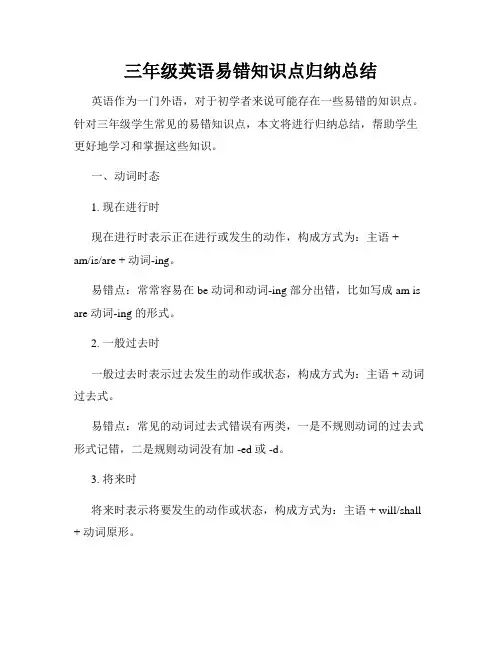
三年级英语易错知识点归纳总结英语作为一门外语,对于初学者来说可能存在一些易错的知识点。
针对三年级学生常见的易错知识点,本文将进行归纳总结,帮助学生更好地学习和掌握这些知识。
一、动词时态1. 现在进行时现在进行时表示正在进行或发生的动作,构成方式为:主语 +am/is/are + 动词-ing。
易错点:常常容易在 be 动词和动词-ing 部分出错,比如写成 am is are 动词-ing 的形式。
2. 一般过去时一般过去时表示过去发生的动作或状态,构成方式为:主语 + 动词过去式。
易错点:常见的动词过去式错误有两类,一是不规则动词的过去式形式记错,二是规则动词没有加 -ed 或 -d。
3. 将来时将来时表示将要发生的动作或状态,构成方式为:主语 + will/shall + 动词原形。
易错点:容易混淆 will 和 shall 的用法,也容易将助动词与动词原形分开,导致句子结构错误。
二、名词单复数名词单复数是英语中的一个重要部分,正确使用名词的单复数形式可以有效地提升语言表达的准确性。
1. 一般名词复数形式大多数名词复数形式的构成是在名词后面加 -s,容易出错的部分通常是不规则名词的复数形式。
易错点:不规则名词的复数形式很多是通过改变词尾字母或整个拼写来构成的,比如 child - children,man - men 等。
其中,“-f” 或“-fe” 结尾的名词变复数时通常将“f” 或“fe” 改为“v”,再加 -es,比如 leaf - leaves。
2. 不可数名词不可数名词是指不能用于复数形式的名词,比如 water,milk 等。
这些名词在句子中通常不与冠词“a/an”连用。
易错点:有时候学生会错误地在不可数名词前面加上冠词“a/an”。
三、冠词使用冠词在英语中起到限定名词的作用,常见的冠词有“a/an”和“the”。
1. 不定冠词不定冠词“a/an”用于表示泛指或第一次提及的名词,它们通常用于单数可数名词前面。
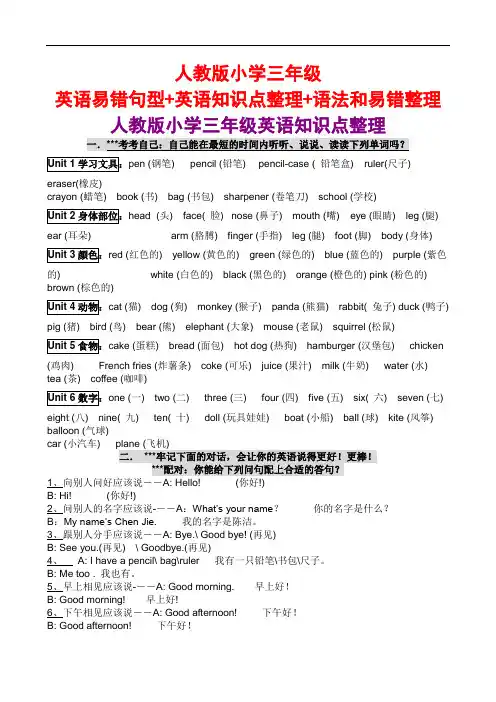
人教版小学三年级英语易错句型+英语知识点整理+语法和易错整理人教版小学三年级英语知识点整理pen (钢笔) pencil (铅笔) pencil-case ( 铅笔盒) ruler(尺子)eraser(橡皮)crayon (蜡笔) book (书) bag (书包) sharpener (卷笔刀) school (学校)head (头) face( 脸) nose (鼻子) mouth (嘴) eye (眼睛)leg (腿) ear (耳朵) arm (胳膊)finger (手指) leg (腿) foot (脚)body (身体)red (红色的) yellow (黄色的)green (绿色的)blue (蓝色的) purple (紫色的) white (白色的) black (黑色的) orange (橙色的) pink (粉色的) brown (棕色的)cat (猫)dog (狗)monkey (猴子)panda (熊猫)rabbit( 兔子) duck (鸭子)pig (猪)bird (鸟) bear (熊)elephant (大象)mouse (老鼠)squirrel (松鼠)cake (蛋糕)bread (面包) hot dog (热狗) hamburger (汉堡包) chicken (鸡肉)French fries (炸薯条)coke (可乐)juice (果汁)milk (牛奶)water (水)tea (茶) coffee (咖啡)one (一) two (二) three (三)four (四) five (五)six( 六)seven (七) eight (八) nine( 九) ten( 十)doll (玩具娃娃) boat (小船)ball (球) kite (风筝) balloon (气球)car (小汽车)plane (飞机)二.***牢记下面的对话,会让你的英语说得更好!更棒!***配对:你能给下列问句配上合适的答句?1、向别人问好应该说――A: Hello! (你好!)B: Hi! (你好!)2、问别人的名字应该说-――A:What’s your name?你的名字是什么?B:My name’s Chen Jie. 我的名字是陈洁。
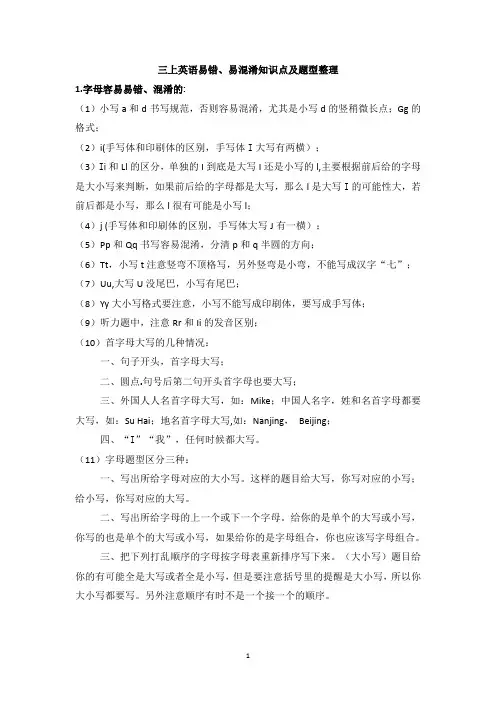
三上英语易错、易混淆知识点及题型整理1.字母容易易错、混淆的:(1)小写a和d书写规范,否则容易混淆,尤其是小写d的竖稍微长点;Gg的格式;(2)i(手写体和印刷体的区别,手写体I大写有两横);(3)I i和Ll的区分,单独的I到底是大写I还是小写的l,主要根据前后给的字母是大小写来判断,如果前后给的字母都是大写,那么l是大写I的可能性大,若前后都是小写,那么l很有可能是小写l;(4)j (手写体和印刷体的区别,手写体大写J有一横);(5)Pp和Qq书写容易混淆,分清p和q半圆的方向;(6)Tt,小写t注意竖弯不顶格写,另外竖弯是小弯,不能写成汉字“七”;(7)Uu,大写U没尾巴,小写有尾巴;(8)Yy大小写格式要注意,小写不能写成印刷体,要写成手写体;(9)听力题中,注意Rr和Ii的发音区别;(10)首字母大写的几种情况:一、句子开头,首字母大写;二、圆点.句号后第二句开头首字母也要大写;三、外国人人名首字母大写,如:Mike;中国人名字,姓和名首字母都要大写,如:Su Hai;地名首字母大写,如:Nanjing,Beijing;四、“I”“我”,任何时候都大写。
(11)字母题型区分三种:一、写出所给字母对应的大小写。
这样的题目给大写,你写对应的小写;给小写,你写对应的大写。
二、写出所给字母的上一个或下一个字母。
给你的是单个的大写或小写,你写的也是单个的大写或小写,如果给你的是字母组合,你也应该写字母组合。
三、把下列打乱顺序的字母按字母表重新排序写下来。
(大小写)题目给你的有可能全是大写或者全是小写,但是要注意括号里的提醒是大小写,所以你大小写都要写。
另外注意顺序有时不是一个接一个的顺序。
2.选择题中选项前的字母序号写大写还是小写。
选择题中选项前的字母序号是大写,你选择写的也是大写,如果选项前的字母序号是小写,你选择写的也是小写。
3.分清说话者是谁?学会找关键词。
(1)例如:Hi,Mike. 你好,迈克。
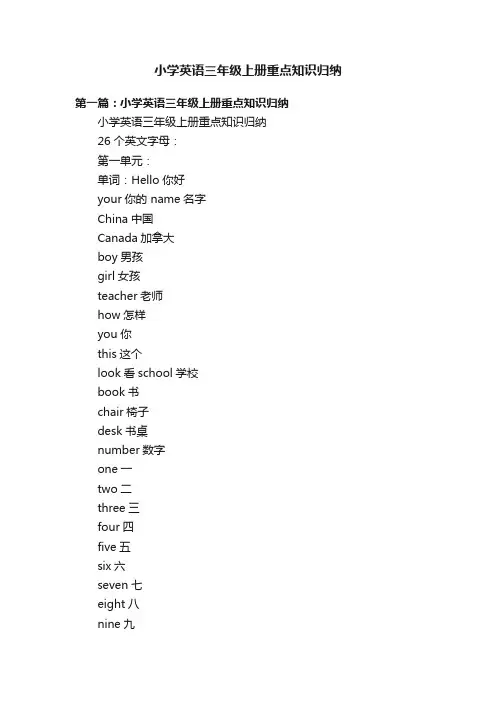
小学英语三年级上册重点知识归纳第一篇:小学英语三年级上册重点知识归纳小学英语三年级上册重点知识归纳26个英文字母:第一单元:单词:Hello你好your你的 name名字China中国Canada加拿大boy男孩girl女孩teacher老师how怎样you你this这个look看school学校book书chair椅子desk书桌number数字one一two二three三four四five五six六seven七eight八nine九ten十stop停have有pencil铅笔pen钢笔ruler直尺crayon彩色蜡笔pencil-box铅笔盒重点句型:1.Hello!/Hi!你好!2.What’s your name? 你叫什么名字? My name is Li Ming.我叫李明。
3.This is a boy/girl/teacher.这是一个男孩、女孩、老师。
4.What’s h is name? 他叫什么名字? His name is Li Ming.他叫李明。
5.What’s her name? 她叫什么名字?Her name is Jenny.她叫詹妮。
6.How are you? 你好吗?I’m fine, thanks.我很好,谢谢。
7.What’s this? 这是什么?It’s a school.(book/chair/desk)这是一所学校(一本书、一把椅子、一张桌子)8.How many? 多少?9.Nice to meet you.见到你很高兴。
10.How many books(rulers/pens/pencils/crayons…)do you have? 你有多少本书(多少把尺子、多少支钢笔、铅笔、蜡笔)? I have two books(rulers/pens/pencils/crayons…)我有两本书(两把尺子、两支钢笔、铅笔、蜡笔)。
11.How many boys? 有多少个男孩?12.See you later.一会儿见。
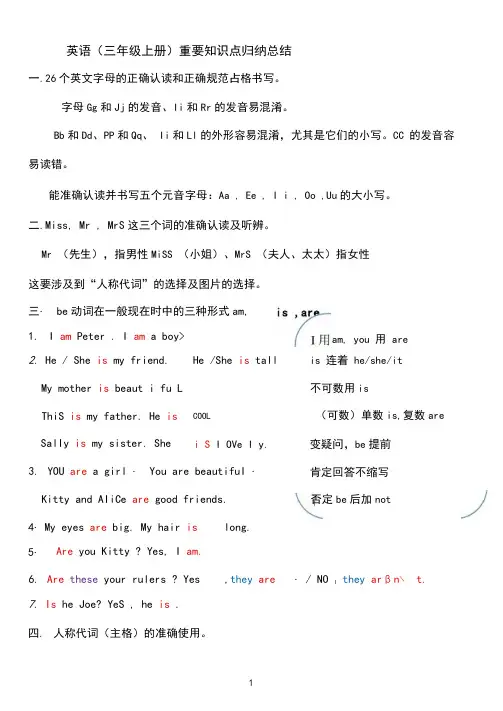
英语(三年级上册)重要知识点归纳总结一.26个英文字母的正确认读和正确规范占格书写。
字母Gg 和Jj 的发音、Ii 和Rr 的发音易混淆。
Bb 和Dd 、PP 和Qq 、 Ii 和Ll 的外形容易混淆,尤其是它们的小写。
CC 的发音容易读错。
能准确认读并书写五个元音字母:Aa , Ee , I i , Oo ,Uu 的大小写。
二.Miss, Mr , MrS 这三个词的准确认读及听辨。
Mr (先生),指男性MiSS (小姐)、MrS (夫人、太太)指女性这要涉及到“人称代词”的选择及图片的选择。
1. I am Peter . I am a boy>Are you Kitty ? Yes, I am.7. Is he Joe? YeS , he is .四. 人称代词(主格)的准确使用。
三∙ be 动词在一般现在时中的三种形式am,2. He / She is my friend. He /She is tall is 连着 he/she/it My mother is beaut i fu L 不可数用isThiS is my father. He is COOL (可数)单数is,复数are SalIy is my sister. She i S I OVe I y. 变疑问,be 提前3. YOU are a girl ∙ You are beautifuI ∙ 肯定回答不缩写4∙ Kitty and AIiCe are good friends. My eyes are big. My hair is long.5∙ 6. Are these your rulers ? Yes ,they are ∙/ NO I they arβn ∖ t. am, you 用 are 否定be 后加not1.第一人称I (我)例如:I am tal I and thin. I am nine.2.第二人称单复数一样,都是you (你,你们)例如:YOU are Kitty.(你是 KittyO)YOU are my friends.(你们是我的朋友<>)3.第三人称单数he (他),she (她)it (它)例如:ThiS is my father. He is fat∙ThiS is my sister. She is tal I and thin∙LOOk at the cat. It is fat∙4.第三人称复数they (他们、她们、它们)HOW much are they? ----- They are ten yuan ∙TheSe are my books. They are new.(它们是新的。
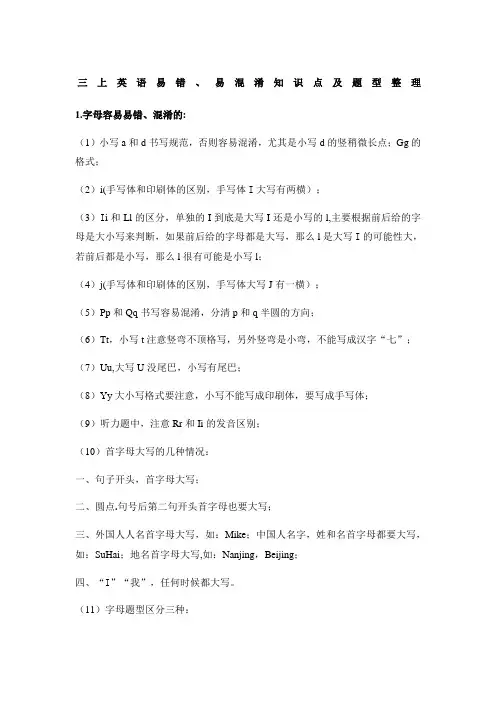
三上英语易错、易混淆知识点及题型整理1.字母容易易错、混淆的:(1)小写a和d书写规范,否则容易混淆,尤其是小写d的竖稍微长点;Gg的格式;(2)i(手写体和印刷体的区别,手写体I大写有两横);(3)I i和Ll的区分,单独的I到底是大写I还是小写的l,主要根据前后给的字母是大小写来判断,如果前后给的字母都是大写,那么l是大写I的可能性大,若前后都是小写,那么l很有可能是小写l;(4)j(手写体和印刷体的区别,手写体大写J有一横);(5)Pp和Qq书写容易混淆,分清p和q半圆的方向;(6)Tt,小写t注意竖弯不顶格写,另外竖弯是小弯,不能写成汉字“七”;(7)Uu,大写U没尾巴,小写有尾巴;(8)Yy大小写格式要注意,小写不能写成印刷体,要写成手写体;(9)听力题中,注意Rr和Ii的发音区别;(10)首字母大写的几种情况:一、句子开头,首字母大写;二、圆点.句号后第二句开头首字母也要大写;三、外国人人名首字母大写,如:Mike;中国人名字,姓和名首字母都要大写,如:SuHai;地名首字母大写,如:Nanjing,Beijing;四、“I”“我”,任何时候都大写。
(11)字母题型区分三种:一、写出所给字母对应的大小写。
这样的题目给大写,你写对应的小写;给小写,你写对应的大写。
二、写出所给字母的上一个或下一个字母。
给你的是单个的大写或小写,你写的也是单个的大写或小写,如果给你的是字母组合,你也应该写字母组合。
三、把下列打乱顺序的字母按字母表重新排序写下来。
(大小写)题目给你的有可能全是大写或者全是小写,但是要注意括号里的提醒是大小写,所以你大小写都要写。
另外注意顺序有时不是一个接一个的顺序。
2.选择题中选项前的字母序号写大写还是小写。
选择题中选项前的字母序号是大写,你选择写的也是大写,如果选项前的字母序号是小写,你选择写的也是小写。
3.分清说话者是谁?学会找关键词。
(1)例如:Hi,Mike.你好,迈克。
三上英语易错易混淆知识点英语中有许多容易混淆或易错的知识点。
下面列举了一些常见的易混淆的词汇、语法和用法。
希望这份列表能够帮助你避免这些错误,提升英语水平。
1. It's和Its: It's是it is或it has的缩写,表示"它是"或"它有"。
而its则是形容词it的所有格形式,表示"它的"。
2. Your和You're: Your是你的所有格形式,表示"你的"。
而you're是you are的缩写形式,表示"你是"。
3. There、Their和They're: There是指示代词,表示"那里"。
Their是形容词they的所有格形式,表示"他们的"。
They're是theyare的缩写形式,表示"他们是"。
4. To、Too和Two: To是介词,表示"到"。
Too是副词,表示"也"或"过于"。
Two是数字,表示"两个"。
5. Affect和Effect: Affect是动词,表示"影响"。
Effect是名词,表示"效果"。
6. Then和Than: Then表示"那么"或"那时",常用于表达时间或顺序。
Than用于比较两个事物,表示"比"或"而"。
7. Weather和Whether: Weater是名词,表示"天气"。
Whether是连词,表示"是否"。
8. Accept和Except: Accept是动词,表示"接受"。
牛津三年级起三年级上册英语易错题归纳全文共3篇示例,供读者参考篇1Oxford Third Grade Up-Third Grade Book Easy Mistakes SummaryAs students progress in their English language learning journey, it is common for them to make mistakes along the way. In the Oxford Third Grade Up-Third Grade Book, there are several common errors that students tend to make. Understanding these mistakes and learning how to correct them can help students improve their English proficiency. In this document, we will highlight some of the common mistakes found in the book and provide tips on how to avoid them.1. Spelling Errors: One of the most common mistakes students make in the Oxford Third Grade Up-Third Grade Book is spelling errors. Students may misspell simple words like "cat" or "dog" or struggle with more complex words like "celebrate" or "environment". To improve spelling, students should practice writing and spelling words regularly. Using flashcards or spelling games can also help reinforce spelling skills.2. Incorrect Verb Tenses: Another common mistake students make is using incorrect verb tenses. For example, students may say "I go to the park yesterday" instead of "I went to the park yesterday". To avoid this error, students should practice using verb tenses in context and pay attention to the timeline of events when speaking or writing.3. Confusing Homophones: Homophones are words that sound the same but have different meanings and spellings. Students often confuse homophones such as "there", "their", and "they're" or "two", "to", and "too". To avoid this mistake, students should pay close attention to the meaning of the words and use them correctly in sentences.4. Subject-Verb Agreement: In the Oxford Third GradeUp-Third Grade Book, students may struggle with subject-verb agreement. For example, students may say "The dogs is barking" instead of "The dogs are barking". To improve subject-verb agreement, students should practice matching subjects with the correct verb form and pay attention to singular and plural nouns.5. Incorrect Word Order: Students may also struggle with word order in sentences. In English, the typical word order is subject-verb-object (SVO). Students may say "I yesterday went school" instead of "I went to school yesterday". Practicingsentence structure and word order can help students improve their English fluency.By understanding and addressing these common mistakes in the Oxford Third Grade Up-Third Grade Book, students can improve their English language skills and become more proficient in reading, writing, and speaking. It is important for students to practice regularly, seek feedback from teachers or peers, and be patient with themselves as they continue to learn and grow in their English language abilities. With dedication and practice, students can overcome these common errors and become more confident and effective English language learners.篇2Oxford Third Grade Third Grade First Edition English Easy Mistake SummaryIn the process of learning English, students may encounter some common mistakes that are easy to make. In this document, we will summarize some of the common mistakes found in the Oxford Third Grade Third Grade First Edition English textbook, aiming to help students identify and correct these errors.1. Incorrect use of articles: One common mistake students make is using the wrong article (a, an, the) in sentences. Forexample, they may say "I have a apple" instead of "I have an apple." It is important to pay attention to the rules for using articles correctly.2. Confusing verb tenses: Students often have difficulty distinguishing between different verb tenses, such as present simple, present continuous, and past simple. For example, they may say "I go to school yesterday" instead of "I went to school yesterday." Practicing verb tenses regularly can help students improve their accuracy.3. Incorrect word order: Another common mistake is using the wrong word order in sentences. For example, students may say "I yesterday went to the store" instead of "Yesterday I went to the store." It is important to pay attention to the correct word order in English sentences.4. Spelling errors: Students may also make spelling mistakes when writing English words. It is important to practice spelling regularly and pay attention to common spelling patterns in English.5. Confusing similar words: Students may mix up words that look or sound similar, such as "there, their, they're" or "your, you're." Paying attention to the meanings and usage of these words can help students avoid confusion.By being aware of these common mistakes and practicing regularly, students can improve their English language skills and become more proficient in using the language. Remember to pay attention to articles, verb tenses, word order, spelling, and similar words to avoid making these easy mistakes. With dedication and practice, students can achieve success in learning English.篇3Oxford Third Grade Upward Third Grade English Common Mistakes SummaryWhen learning English, students often make mistakes in grammar, pronunciation, vocabulary, and spelling. In the Oxford Third Grade Upward Third Grade English textbook, there are several common mistakes that students tend to make. In this article, we will summarize some of these common mistakes and provide explanations and examples to help students correct them.1. Confusing "their," "there," and "they're":One common mistake that students make is confusing the words "their," "there," and "they're."- "Their" is a possessive pronoun used to show ownership. For example, "Their house is big."- "There" is an adverb used to indicate a place or position. For example, "The book is over there."- "They're" is a contraction of "they are." For example, "They're going to the park."2. Confusing "your" and "you're":Another common mistake is confusing the words "your" and "you're."- "Your" is a possessive pronoun used to show ownership. For example, "Is this your pencil?"- "You're" is a contraction of "you are." For example, "You're a good student."3. Confusing "its" and "it's":Students often mix up "its" and "it's."- "Its" is a possessive pronoun used to show ownership by a non-human entity. For example, "The dog wagged its tail."- "It's" is a contraction of "it is" or "it has." For example, "It's raining outside" or "It's been a long day."4. Confusing "to," "too," and "two":Many students struggle with the words "to," "too," and "two."- "To" is a preposition used to indicate direction or purpose. For example, "I am going to the store."- "Too" is an adverb used to show an excessive amount or also. For example, "I am too tired to go out" or "Can I come too?"- "Two" is the number 2. For example, "I have two apples."5. Confusing "its" and "it's":It is common for students to mix up "its" and "it's."- "Its" is a possessive pronoun used to show ownership by a non-human entity. For example, "The tree lost its leaves."- "It's" is a contraction of "it is" or "it has." For example, "It's a nice day" or "It's been a long time."6. Incorrect use of past tense verbs:Students often struggle with using past tense verbs correctly. For example, instead of saying "I goed to the store," students should say "I went to the store."7. Confusing "than" and "then":Another common mistake is mixing up "than" and "then."- "Than" is used in making comparisons. For example, "I am taller than you."- "Then" is used to indicate time or sequence. For example, "First we went to the park, then we had lunch."8. Mispronouncing words:Students may also mispronounce words, especially words with silent letters or consonant blends. For example, "knight" is pronounced as "nait," not "k-nig-h-t".By being aware of these common mistakes and practicing, students can improve their English language skills and communicate more effectively. Remember, practice makes perfect!。
郑州市高中英语必修三Unit3DiverseCultures易混淆知识点单选题1、A sport with a broom on ice ________ requires bowling ________ makes curling one of the most unique sports out t here.A.that … precisionB.that … diversityC./ … precisionD./ … diversity答案:A考查定语从句和名词词义辨析。
句意:冰壶是一项要求精准度的运动,它在冰上要使用冰刷,这使得冰壶成为最独特的运动之一。
precision 精准度;diversity 多样性。
第一个空处考查限定性定语从句,先行词是sport,在从句中作主语,应用关系代词that或which,且不能省略;第二个空处考查名词词义辨析,根据常识可知,冰壶要求精准度,应用名词precision。
故选A项。
2、Seeing her idol appear on the stage, Dorothy was unable to ________ her excitement. A.containB.refrigerateC.envelopD.close答案:A考查动词词义辨析。
句意:看到她的偶像出现在舞台上,多萝西无法抑制她的兴奋。
A. contain控制,遏制;B. refrigerate冷藏;C. envelop包住;D. close关闭。
根据后文“her excitement”指控制兴奋,故选A。
3、The internet is a technological wonder, __________far-reaching changes in all aspect of our lives. A.bringing aboutB.holding backC.getting acrossD.looking out for答案:A考查动词短语辨析。
三年级英语上册易错重点知识1、Happy Teachers' Day教师节快乐(9月10号)Happy Halloween! 万圣节快乐!(11月1号)Happy New Year! 新年快乐!Happy Birthday! 生日快乐!2、panda (熊猫) ----CHINA(中国)beaver(海狸)----CANDA(加拿大)eagle(鹰)----USA (美国)kangaroo(袋鼠)----AUSTRALIA(澳大利亚)3、How are you? (你好吗? )How old are you? (你多大了?)4、--Can I have ( an ) apple/orange?--Sure. Here you are.*an 用在以元音因素开头的单词前。
5、How many(balloons)?—Ten.*How many+可数名次的复数。
How many balloons/cakes/gifts/…?多少个气球/蛋糕/礼物/……?6、易混单词:doll玩具娃娃、ball球、dog狗、kite风筝、cat猫。
7 、Have some chicken/bread/juice/tea/water/coffee.* chicken/bread/juice/tea/water/coffee是不可数名词,不能加s。
8、中国国旗的颜色是:red and yellow.9、I like red/purple/…*颜色前不加the。
10、吃西餐时刀子应放在盘子的right(右边),叉子放在left(左边)。
11、Have some cakes\hot dogs\hamburgers.12、F rench fries 、C oke。
*F、C要大写。
13、Nice to meet you.*不能用too,too是也的意思。
外研版小学英语三年级上册易错知识点总结第一部分:词汇及其分类1.颜色类:red 红色的 blue 蓝色的yellow黄色的 green绿色的black黑色的orange橙色的purple紫色的2.数字类:one一 two 二 three 三 four四five五 six六 seven七 eight八nine九ten十eleven十一twelve十二3.动物类:panda熊猫dog狗 cat猫bird鸟 chameleon变色龙4.教室设施:door 门 window窗户 blackboard黑板 desk书桌 chair椅子5.学习用品:pencil铅笔 pen钢笔 book书 schoolbag书包6.职业:teacher 教师 pupil小学生doctor医生 policeman 警察nurse护士driver司机 farmer农民7.家庭成员:mother母亲 father父亲sister姐妹 brother兄弟grandpa祖父,外祖父 grandma祖母,外祖母8.人体器官:head头 hand 手body 身体arm胳膊leg 腿foot脚nose鼻子eye 眼睛 mouth嘴巴 ear耳朵9.人称代词(主格):I 我 you你 he他 she她 it它人称代词(宾格):放在句子末尾me 我 you 你10.形容词性物主代词:my 我的 your 你的his 他的 her 她的11.特殊疑问词:what什么 where 哪里 how 怎么样 how many 多少 how old 多少岁12.动作词:look(at) 看 see 看见 point(to) 指向13.介词:in在……里 on在……上14.be动词:is是 am是 are是我用am,你用are,is连着她他它,复数后边全用are15.缩写词:1、I’m = I am 我是2、what’s = what is 是什么3、it’s = it is 它是4、you’re = you are 你是5、here’s = here is 这是6、don’t = do not 不7、isn’t = is not 不是8、where’s = where is 在哪里9、she’s = she is 她是10、he’s = he is 他是第二部分、情景交际:一、问候语:Hello! 你好! Hi! 你好!早上见面说:Good morning. 上午好。
三上英语易错易混淆知
识点
Document serial number【NL89WT-NY98YT-NC8CB-NNUUT-NUT108】
三上英语易错、易混淆知识点及题型整理
1.字母容易易错、混淆的:
(1)小写a和d书写规范,否则容易混淆,尤其是小写d的竖稍微长点;Gg 的格式;
(2)i(手写体和印刷体的区别,手写体I大写有两横);
(3)Ii和Ll的区分,单独的I到底是大写I还是小写的l,主要根据前后给的字母是大小写来判断,如果前后给的字母都是大写,那么l是大写I的可能性大,若前后都是小写,那么l很有可能是小写l;
(4)j(手写体和印刷体的区别,手写体大写J有一横);
(5)Pp和Qq书写容易混淆,分清p和q半圆的方向;
(6)Tt,小写t注意竖弯不顶格写,另外竖弯是小弯,不能写成汉字“七”;(7)Uu,大写U没尾巴,小写有尾巴;
(8)Yy大小写格式要注意,小写不能写成印刷体,要写成手写体;
(9)听力题中,注意Rr和Ii的发音区别;
(10)首字母大写的几种情况:
一、句子开头,首字母大写;
二、圆点.句号后第二句开头首字母也要大写;
三、外国人人名首字母大写,如:Mike;中国人名字,姓和名首字母都要大写,如:SuHai;地名首字母大写,如:Nanjing,Beijing;
四、“I”“我”,任何时候都大写。
(11)字母题型区分三种:
一、写出所给字母对应的大小写。
这样的题目给大写,你写对应的小写;给小写,你写对应的大写。
二、写出所给字母的上一个或下一个字母。
给你的是单个的大写或小写,你写的也是单个的大写或小写,如果给你的是字母组合,你也应该写字母组合。
三、把下列打乱顺序的字母按字母表重新排序写下来。
(大小写)题目给你的有可能全是大写或者全是小写,但是要注意括号里的提醒是大小写,所以你大小写都要写。
另外注意顺序有时不是一个接一个的顺序。
2.选择题中选项前的字母序号写大写还是小写。
选择题中选项前的字母序号是大写,你选择写的也是大写,如果选项前的字母序号是小写,你选择写的也是小写。
3.分清说话者是谁?学会找关键词。
(1)例如:Hi,Mike.你好,迈克。
(说话者是别人)
Hi,I’mMike.你好,我是迈克。
(说话者是迈克自己)关键词:I’m
(2)当对方想赞赏你的衣服时,对方说赞扬的话:It’nice.It’sgreat等,而你回答感谢的话:Thankyou!
4.圈出合适的词,补全句子;(题目做法)
She(am/is/are)YangLing.这题既要圈出单词,又要补全单词,如果是选填字母或数字序号,只要选就行了。
5.He和He’s;She和She’s到底选哪一个。
这样的题目先找关键词一:性别;再找关键词二:所给句子本身有没有is。
如:
(1)ismygrandpa.AHe’sBHeCShe’sDShe这题根据grandpa知道是男性,句子本身有is,所以不能选He’s,因为He’s=Heis,就多了一个is,这题选B (2)mygrandma.AHe’sBHeCShe’sDShe而这题根据grandma知道是女性,句子本身没有is,所以要用She’s,不能用She,这题选C。
6.a和an的用法。
(1)两者都表示“一,一个”以辅音音素开头的单词前表示一个用a,以元音音素开头的单词前表示一个用an。
如:
abanana;apie;anapple;anelephant(一头大象);anicecream;anorange;(2)选择题选a还是an
It’sanegg;而It’saredegg这题紧接着的是red不是元音音素开头的,所以用a;It’sanorangeorange(它是一个橙色的橙子)
7.易混淆单词和句型
hat圆边帽,花边帽;dress连衣裙T-shirt短袖t恤,短袖衬衫
cap鸭舌帽;skirt短裙shirt长袖t恤,长袖衬衫
T-shirt和skirt的书写区别。
8.如何根据图上太阳的位置判断时间。
要点:上北下南,左西右东,太阳从东边升起。
所以太阳若在图片的最左边到中间之间的位置是早上、上午morning;太阳在中间或者中间向左的位置是中午、下午afternoon;太阳在最左边快要落山的时候是傍晚evening;evening 除了晚上还有傍晚的意思。
9.听力题型区分:“判断下列各句与所听内容的意思是否相同。
”和“判断下列各句与所听内容是否一致”是两种题目意思。
“判断下列各句与所听内容的意思是否相同”是指只要所听句子的整体意思和题目所给的意思一样就算对,有的时候单词的顺序或者说法不同,但是表达的意思相同,这样就算对。
如果题目换成“判断下列各句与所听内容是否一致”是听的句子和所给句子一个词都不能差,差一个单词也是错的。
10.please的不同意思
单独的please意思是“请”;句子“Yes,please.”的意思是“好的,谢谢!”
11.like的不同意思
单独的like意思是“喜欢”;句子“Wouldyoulike...
”的意思是“你想要...吗”
12.wear和bear的区别
wear是“穿”的意思;bear是“熊”例如:wearbrown意思是“穿着棕色的衣服”brownbear意思是“棕色的熊”选择题中需看清到底是wear还是bear。
13.doll,door以及ball的区别
doll洋娃娃,布偶;door门;要听力题中要能区分doll和door发音,短音长音
doll洋娃娃,布偶;ball球,默写能区分。
14.be动词以及人称代词的用法
be动词是am,is,are三者的原形,be不直接出现在句子中,而是以am,is,are 的形式出现。
建议用歌谣熟记be动词的用法:
我(I)用am,你(you)用are,is用在他(he)、她(she)、它(it)第三人称单数is复数are,学好英语就靠它。
人称代词
15.注意翻译的准确性
Thisisforyou.(这是给你的。
)
Itisforyou.(它是给你的.)=It’sforyou.
Thisisadoll.(这是一个洋娃娃。
)
Itisadoll.(它是一个洋娃娃。
)=It’sadoll.
16.近远处及其单复数的区别
What’sthis这个是什么(是问近处的这个东西是什么,单数)What’sthat那个是什么(是问远处的那个东西是什么,单数)Whatarethese这些是什么(是问近处的这些是什么,复数)Whatarethose那些是什么(是问远处的那些是什么,复数)。